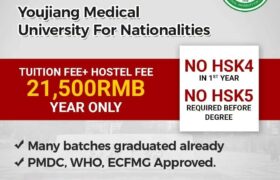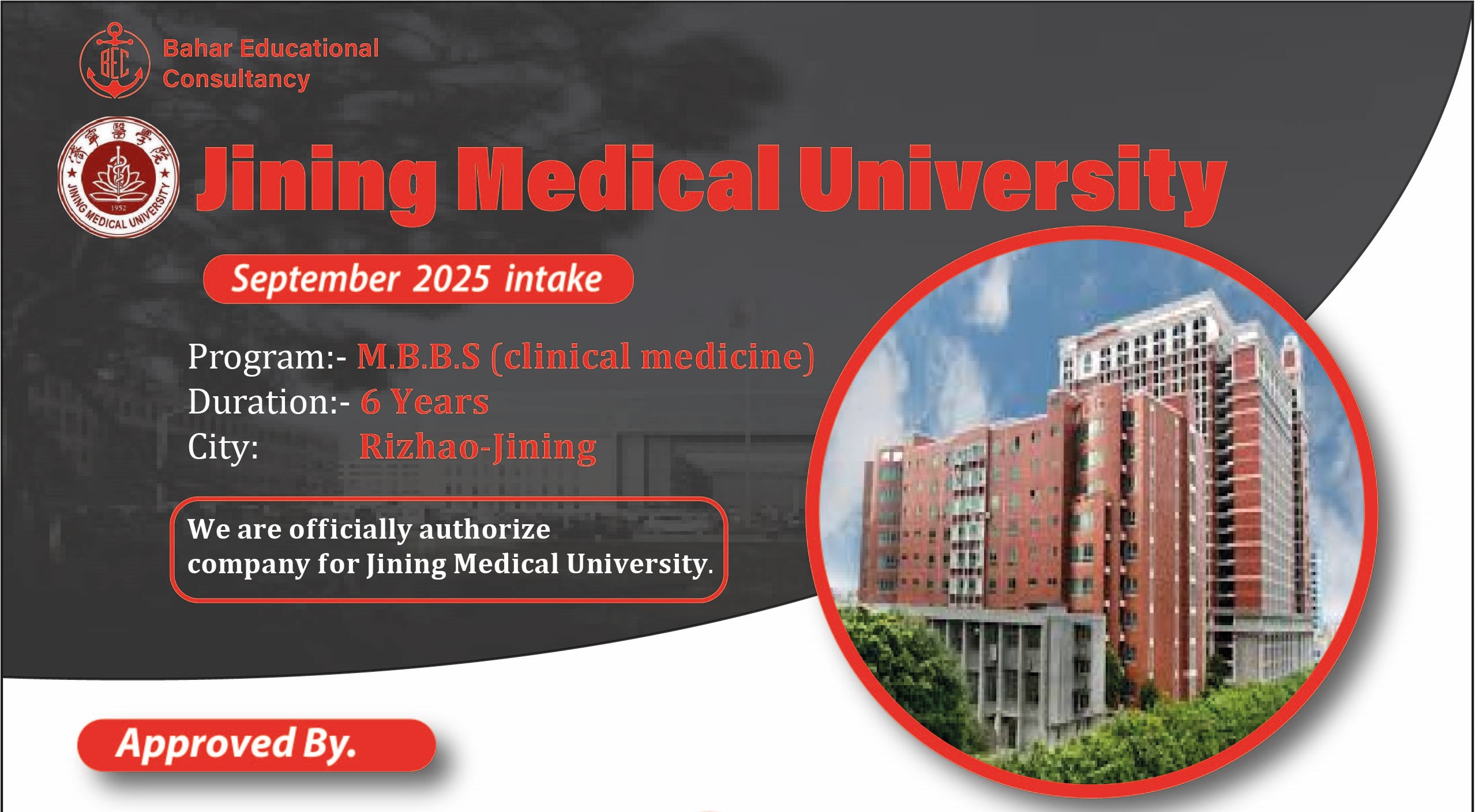
Introduction
Pursuing an MBBS degree abroad has become an increasingly popular choice among Pakistani students, and China stands out as a top destination. With its affordable tuition fees, globally recognized universities, and modern infrastructure, China offers a compelling option for medical education. This comprehensive guide provides detailed insights into studying MBBS in China for the academic year 2025–2026, covering everything from admission requirements to living expenses. MBBS in China mbbsabroadpk.comMBBS.NET.PK
Why Choose China for MBBS?
1. Affordable Tuition Fees
Chinese medical universities offer competitive tuition fees, ranging from RMB 21,000 to 48,000 per year (approximately PKR 1.2 to 2 million). This affordability makes China an attractive option compared to other countries.
2. Globally Recognized Degrees
Degrees from Chinese medical universities are recognized by major global organizations, including:EaziLine International
- World Health Organization (WHO)
- Pakistan Medical and Dental Council (PMDC)
- Educational Commission for Foreign Medical Graduates (ECFMG)
- General Medical Council (GMC)
- National Medical Commission (NMC) IndiaEaziLine International
Graduates are eligible to take international licensing exams such as USMLE, PLAB, and NLE. NICE Consultants+1EaziLine International+1
3. English-Medium Programs
Many Chinese universities offer MBBS programs taught entirely in English, eliminating language barriers for international students.Study MBBS in China+1MBBS.NET.PK+1
4. Modern Infrastructure and Facilities
Chinese medical universities are equipped with state-of-the-art laboratories, research centers, and affiliated hospitals, providing students with hands-on clinical experience.
5. Cultural Exposure and Safety
Studying in China offers a unique cultural experience. The country is known for its safety, with low crime rates and a welcoming environment for international students. MBBS.NET.PKEaziLine International
Eligibility Criteria
To apply for an MBBS program in China, Pakistani students must meet the following requirements:
- Academic Qualifications: Minimum of 70% marks in FSc (Pre-Medical) or equivalent.
- Age Limit: Typically between 18 to 25 years. Some universities may accept students up to 30 years old.
- Language Proficiency: Proficiency in English is required. Some universities may require proof through standardized tests.EaziLine International+2Zahi Notes+2mbbsabroadpk.com+2
Admission Process

Step 1: Choose a University
Select a university recognized by PMDC and WHO. Consider factors such as tuition fees, location, and medium of instruction.EaziLine International+1NICE Consultants+1
Step 2: Prepare Required Documents
Commonly required documents include:Study MBBS in China+1mbbsabroadpk.com+1
- Scanned copy of passport
- Academic transcripts and certificates
- Passport-sized photographs
- Medical examination report
- Police clearance certificate
Step 3: Submit Application
Apply directly through the university’s official website or through authorized representatives.
Step 4: Receive Admission Letter and JW202 Form
Upon acceptance, the university will issue an admission letter and a JW202 form, necessary for the visa application.mbbsabroadpk.com
Step 5: Apply for Student Visa (X1 Visa)
Submit the required documents, including the admission letter and JW202 form, to the Chinese Embassy or Consulate in Pakistan.
Cost Breakdown
Tuition Fees
- MOE-Listed Universities: RMB 30,000 to 48,000 per year (approximately PKR 1.2 to 2 million).
- Non-MOE Universities: RMB 18,000 to 35,000 per year (approximately PKR 0.7 to 1.4 million). WRSEaziLine International
Accommodation
- On-Campus Dormitories: RMB 6,000 to 12,000 per year (approximately PKR 240,000 to 480,000). mbbsabroadpk.com+3WRS+3EaziLine International+3
Living Expenses
- Monthly Expenses: RMB 1,200 to 1,500 (approximately PKR 48,000 to 60,000), covering food, transportation, and other necessities.
Other Expenses
- Health Insurance: RMB 600 to 1,000 per year.
- Visa Fees: Approximately PKR 4,500 for a single-entry visa. WRSmbbsabroadpk.com+1NICE Consultants+1
Scholarships for Pakistani Students
Several scholarships are available to help Pakistani students finance their MBBS studies in China:
- Chinese Government Scholarship (CSC): Covers tuition, accommodation, and a monthly stipend.
- Jasmine Jiangsu Government Scholarship: Offers financial support to students studying in Jiangsu province.
- Silk Road Scholarship: Designed for students from countries along the Silk Road Economic Belt. EaziLine International+2Study MBBS in China+2NICE Consultants+2
Top Medical Universities in China
Here are some reputable medical universities in China recognized by PMDC and WHO:
| University Name | Tuition Fee (RMB/year) | Hostel Fee (RMB/year) | Medium of Instruction |
|---|---|---|---|
| Shihezi University | 30,000 | 5,000 | English |
| Ningxia Medical University | 29,800 | 5,000 | English |
| Nanjing Medical University | 34,000 | 6,000 | English |
| University Name | Tuition Fee (RMB/year) | Hostel Fee (RMB/year) | Medium of Instruction |
|---|---|---|---|
| Jiangsu University | 34,000 | 5,000 | English |
| Qingdao University | 30,000 | 6,000 | English |
| China Medical University | 40,000 | 7,000 | English |
| Dalian Medical University | 42,000 | 8,000 | English |
| Xiamen University | 38,000 | 6,000 | English |
| Zhejiang University | 48,000 | 8,000 | English |
Note: Fees vary based on university, location, and program duration. Always confirm from the university’s official website or an authorized representative.
PMDC Recognition and Licensing After Graduation

Pakistani students graduating from Chinese medical universities must follow a specific process to practice in Pakistan:
1. Equivalence Certificate from HEC
- Submit degree documents for equivalency.
- Degree must be from a PMDC-recognized university.
2. PMDC Registration and Licensing Exam
- Appear in the NLE (National Licensing Examination).
- Passing the NLE is mandatory to practice in Pakistan.
3. House Job (Internship)
- After NLE, complete one year of house job at a PMDC-recognized hospital.
4. Permanent License
- Upon successful completion of the internship, the candidate receives a permanent license to practice medicine in Pakistan.
Duration of MBBS in China
The MBBS program in China typically spans 6 years, divided as follows:
- 5 years of academic study (theory and clinical rotations)
- 1 year of internship (either in China or in Pakistan)
Internship in Pakistan is accepted by PMDC only if approved beforehand.
Curriculum and Clinical Training
Chinese medical universities follow international standards in their MBBS curriculum:
Core Subjects:
- Anatomy
- Physiology
- Biochemistry
- Pathology
- Pharmacology
- Microbiology
- Internal Medicine
- Surgery
- Pediatrics
- Obstetrics & Gynecology
Clinical Training:
- Begins from 3rd or 4th year.
- Conducted in affiliated hospitals.
- Students get hands-on experience under supervision.
Medium of Instruction:
- Entire program is in English, but students are encouraged to learn basic Chinese (Mandarin) to communicate effectively with patients during clinical rotations.
Life in China for Pakistani Students

1. Cultural Environment
- China offers a mix of modern cities and rich historical culture.
- Students from all over the world study here, promoting global exposure.
2. Food and Halal Options
- Halal food is widely available.
- University canteens often cater to international dietary needs.
3. Weather
- Varies by region:
- North China: Cold winters, mild summers.
- South China: Mild winters, hot summers.
- Students should choose a university considering their weather preference.
4. Transportation
- Extensive public transportation system.
- Students get access to subway passes and bus discounts.
Safety and Support for International Students
- University campuses are safe and have 24/7 security.
- International Student Offices (ISOs) help foreign students adjust.
- Emergency medical services and police support are always accessible.
- Pakistani student communities and societies are present in most universities.
How to Apply – Step-by-Step Guide
1. Choose a Recognized University
- Ensure it’s listed by PMDC and MOE China.
2. Collect Necessary Documents
- Passport
- Academic Certificates (Matric & FSc)
- Medical Report
- Passport-size Photos
- Police Character Certificate
3. Submit Application
- Directly to university or via trusted consultancy services.
4. Receive Admission Letter and JW202 Form
- These are required for visa processing.
5. Apply for Student Visa (X1)
- Submit documents at the Chinese Embassy in Islamabad or Karachi.
6. Departure and Arrival
- Book flight, complete travel arrangements.
- Reach before semester starts (usually in September or March).
Important Points to Remember
- Always verify if the university is on PMDC’s approved list.
- Avoid universities with low teaching standards or lacking English MBBS programs.
- Understand the NLE requirement before joining.
- Avoid middlemen and verify consultancy credentials.
- Compare universities on the basis of clinical exposure, fees, and hostel facilities.
Frequently Asked Questions (FAQs)
Q1. Is MBBS in China valid in Pakistan?
Yes. Degrees from PMDC-approved Chinese universities are valid. Graduates must clear the NLE to practice.
Q2. Is NEET or MDCAT required?
Yes. For Pakistani students, MDCAT is mandatory to apply for MBBS in China.
Q3. Can I do a house job in Pakistan after studying MBBS in China?
Yes. After passing the NLE, students can do their internship in Pakistan at PMDC-recognized hospitals.
Q4. What are the best Chinese universities for MBBS?
Some top picks include:
- Shihezi University
- Nanjing Medical University
- Dalian Medical University
- Qingdao University
- China Medical University
Q5. Are scholarships available?
Yes. CSC and provincial government scholarships are available, but competition is high.
Final Thoughts
China is an ideal destination for Pakistani students aspiring to become doctors. With globally recognized degrees, affordable costs, modern infrastructure, and a safe environment, MBBS in China is a smart and strategic choice.
If you’re planning to study MBBS abroad in 2025–2026, China should be at the top of your list. However, thorough research, planning, and preparation are essential for a smooth academic journey.
Call to Action
Want expert help to apply for MBBS in China for 2025–26? Contact us today for:
- University selection
- Scholarship guidance
- Visa processing
- Travel support
- Complete admission assistance
Apply Now.
RELATED POSTS
View all





